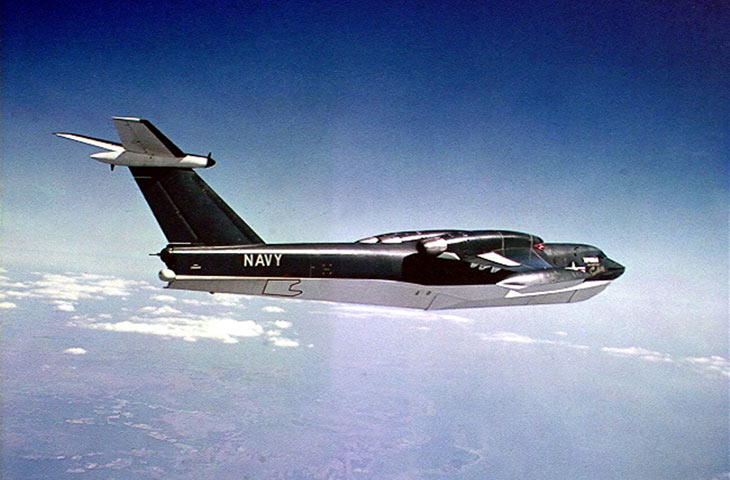Martin
P6M SeaMaster
The Martin P6M SeaMaster was a large flying boat built for the
United States Navy in the mid-50s by the Glenn L. Martin Company.
It was envisaged as a strategic bomber with the primary role of mine-laying,
although it could also drop conventional bombs and be used for maritime
reconnaissance.
The Martin P6M SeaMaster was chosen by the U.S. Navy over a rival
design from Convair. The Navy brief had called for a seaplane with
the ability to carry 30,000 lbs (14,000 kgs) of weapons over a range
of 1,500 miles (2,400 kms). The aircraft also had to be capable of
Mach 0.9 (686 mph / 1,100 km/h) at low altitude. On accepting the
Martin P6M SeaMaster design, the navy ordered two prototypes, with
a further six pre-production aircraft provisisionally ordered and
a projected final order of 24 production aircraft.
Work began on the aircraft in the early 1950s, with the first flight
taking place on July 14th 1955. The designers had originally planned
to use a Curtiss-Wright turbo-ramjet engine, but due to unforeseen
problems they switched to a more conventional Allison J71-A-4 turbojet.
The engines, four of them, were fitted in pairs over the top of the
wings to prevent water spray entering. The wings featured wing tip
fuel tanks, which doubled as floats when the aircraft was on the water.
The Martin P6M SeaMaster borrowed several features of Martin's earlier
XB-51 bomber
prototype, including the T-tail and rotating bomb bay.

Extremely early on in the test program the Martin P6M SeaMaster suffered
from several major setbacks. Firstly it was discovered that the engines
were mounted too close to the fuselage causing the hot exhaust gases
to literally burn away at the fuselage. This was rectified by pointing
the engines slightly outward to keep the exhaust away from the airframe.
However this was nothing compared to the events of December 7th 1955
when the first prototype crashed due to a control system fault killing
all four on board, Navy pilot Lieutenant Commander Utgoff, and Martin
employees, Morris Bernhard, assistant pilot, Herbert Scudder, flight
engineer, and H.B. Coulon, flight test engineer.
The cause of the crash was attributed to the horizontal tail moving
to full up position without commands from the pilot. The aircraft
was subjected to a 9 g outside loop and broke up in the air befor
crashing into the Potomac River in Maryland.
Less than a year later, on November 9th 1956 the second prototype
was also destroyed, again due to a malfunction with the vertical stabilizer.
However this time it was because of a modification intended to rectify
the original problem. Thankfully this time around all four on board
were able to safely eject before the aircraft impacted the ground
and was completely destroyed.
Test flights of the Martin P6M SeaMaster resumed in early 1958 when
the first pre-production aircraft (YP6M-1) was finished. Five more
aircraft were built during the year, and no major incidents occured.
Generally the aircraft was fulfilling its requirements, however the
engines were proving problematic and spray ingestion when fully loaded
was proving troublesome too. Control issues, although less serious
than before, were still manifesting themselves under certain trim
settings too. Due to these issues the Navy decided that the aircraft
required a thorough redesign.
The U.S. Navy and Martin developed an upgraded version of the aircraft
called the P6M-2. This had new, more powerful Pratta and Whitney J75
engines, an aerial refueling probe, upgraded avionics and a redesigned
canopy with better visibility.
Three examples of the upgraded aircraft were built in the first half
of 1959. The new aircraft were extremely fast for such a large aircraft,
and very sturdy to withstand the rough water takeoff and landings.
There were several minor issues with the new aircraft which needed
to be resolved before it could be accepted by the Navy, but Martin's
engineers soon had the aircraft ready for operational flight.
Then disaster struck. Just at the point at which the aircraft was
to be included in the U.S. Navy inventory - in fact crews were already
training for its arrival - it was canceled. The Eisenhower administration
had ordered the Navy to make cut backs, and the P6M SeaMaster was
one of the unlucky ones. By the time of its cancelation the project
had cost over $400 million (more than $2.5 billion in today's money).
All of the aircraft were scrapped, with only one tail section remaining
and held at the Glenn L. Martin Maryland Aviation Museum.
|

